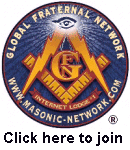
The GFN Treasure Chest Archives
www.masonic-network.com
"Where Master Masons Communicate"

 |
The GFN Treasure Chest Archiveswww.masonic-network.com |
 |
I would say that almost all Masons know the four 'old Lodges' that gathered together to form the Premiere Grand Lodge in 1717, but just in case it has slipped your mind, they were the Lodges that met at the Goose and Gridiron Ale-House in St. Paul's Church-yard; the Crown and Ale-house in Parker's Lane near Drury Lane; the Apple-Tree Tavern in Charles Street, Covent Garden; and the Rummer and Grapes Tavern in Channel-row, Westminster.
According to Coil's Encyclopedia there is at times some confusion about the first two meetings of the Grand Lodge and where the first one was held. Some think the Grand Lodge was formed at the Apple Tree Tavern in 1716, but "Brother and Dr. Anderson tells us that only a Grand Lodge Pro Tempore was then formed, and since no Grand Master was then elected and no laws or regulations of any kind formulated, it amounted to only a group agreement to meet the following June 24th to form the Grand Lodge, which was done at the Goose and Gridiron Ale House."
There were only three Quarterly Communications held and then the Annual Communication on June 24th. The Quarterly Communications were held on Michaelmas, (September 29th, the feast of St's Michael, Gabriel and Raphael;) one at Christmas, (December 27th;) and one on Annunciation Day, (March 25.) So the Communication on June 24th would not have been a Quarterly Communication but the Annual Communication.
It was at the Lodge that met at the Goose and Gridiron Ale-House that the Premiere Grand Lodge was born and constituted to become what we know as the birthplace of modern Freemasonry.
The building known as the Goose and Gridiron Tavern is said to date back to an unknown year before the Great London Fire of 1666. Prior to that year there was a building on the site of the Goose and Gridiron that was a public house, called the Mitre, and the Mitre was said to be the first music house in London. The owner of the house, Robert Hubert, was a collector of curios and he kept them on display in his building, so the Mitre was a combination public house being a tavern, museum and music house. The Mitre was destroyed in the great fire in 1666 and soon after the fire another building was erected under the name of the Lyre, because a musical society held its meetings there. The coat of arms of the building was the Lyre of Apollo, having for its crest a Swan. [This is important as to why the name was changed to the Goose and Gridiron.]
It was later on with a new owner of the building that the name was changed to the Goose and Gridiron. This was because the new owner was no lover of music, and he decided on the coat of arms and sign with "a goose striking the bars of a gridiron with its foot." The purpose of this sign, which was considered a curious device, was to cast ridicule upon musical societies, which were using the Swan and Harp as one of their principle signs.
By the way a gridiron is a utensil having parallel bars to broil meat over an open fire. In the game of Football the field is sometimes called a gridiron because of the parallel white lines crossing the field every five yards.
In 1897 Brother J. Ross Robertson, a Canadian Mason, visited the Goose and Gridiron Tavern just prior to it being demolished. In the 'History of Freemasonry in Canada' he gives this description of the historic Masonic meeting place: "It was four stories in height. The ground floor had a doorway and three windows to the west, while each of the upper stories had four windows each. The sign of the Goose and Gridiron was directly over the doorway. During the day the odd-looking figure whose form did not improve with age, was a curiosity to passers-by, and many a tourist patronized the bar, not so much as a longing to satisfy his thirst, but rather to have a word of explanation as to why a bird popular at Christmastide should grace the front of a London 'pub." The sign of the Goose and Gridiron is now on display in the museum of the United Grand Lodge of England.
The Goose and Gridiron had a paneled bar and a quite narrow winding stairway leading up to a dining room. "And in this room, where was held the Festival of St. John the Baptist in the third year of the first of the Georges, Mr. Anthony Sayer, Gentleman, was placed at the head of the craft as Grand Master. Standing in this room one can scarcely realize that in so ordinary a place, with such unpretentious surroundings an institution which has today its triumph, in a world of good accomplished, with members in every clime and under every sky, should have had its commencement." (Brother Robertson.)
The Goose and Gridiron building was demolished not long after Brother Robertson visited the place. The Goose and Gridiron was so popular in the early 18th century that in 1713 a man named Ned Ward published a book called 'A Vade Mecum for Malt Worms or a guide to Good Fellows, with a hint on the props and principal Customers of each House, in a method so plain that any thirsty person may easily find the nearest way from one house to another." [Quite a title] That title seems to me to be like a 'pub crawler map,' which can be found in some cities. Well anyway, in that book was a poem about the Goose and Gridiron Tavern. I don't have a copy of the poem, but in the book 'History and Evolution of Freemasonry' it says the poem touched on the old sign; the pillar which supports the chimney; the skittle-ground on top of the house; and a handsome maid named Hannah.
One more quick note, this time about the Rummer and Grapes: "It is presumed the tavern took its name from a drinking glass called 'The Rummer,' which was of large proportions." A Rummer is a drinking glass "with a curved bowl and a short, thick stem, sometimes collared and supported by a square or round flat foot." So unlike the Goose and Gridiron, which was a parody on the Swan and Lyre, the Rummer and Grapes was named after the drinking establishment that it was.
The Lodge which met at the Goose and Gridiron eventually gained the name of Lodge of antiquity and at the union of 1813 was assigned number 2; the Lodge which met at the Crown Ale-House was stricken from the rolls in 1740; the Lodge which met at the Apple-Tree Tavern in 1768 gained the name of Fortitude in 1818 it merged with Old Cumberland Lodge and is now known as Fortitude and Old Cumberland Lodge #12; (It is a point of interest that the First Grand Master of the Premier Grand Lodge was a member of the Lodge which met at the Apple-Tree Tavern.); finally the Lodge that met at the Rummer and Grapes still exists as Royal Somerset House and Inverness Lodge #4 under the United Grand Lodge of England.
"All excess is ill, but drunkenness is of the worst sort. It spoils health,
dismounts the mind, and unmans men. It reveals secrets, is quarrelsome,
lascivious, impudent, dangerous and bad."
William Penn.
This is a bit of MASONIC HISTORY
Can't find it elsewhere